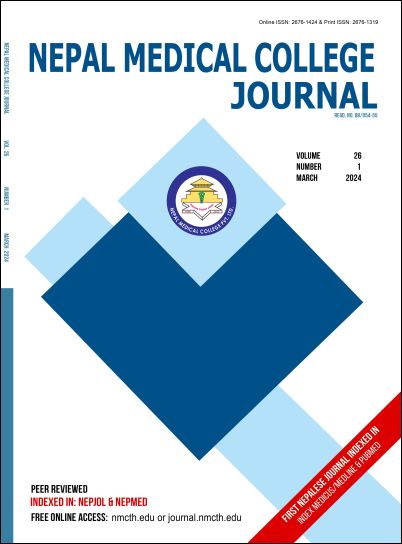Effectiveness of Health Education Intervention on Knowledge Regarding Prevention of Cervical Cancer among Women in a Selected Community of Kathmandu, Nepal
DOI:
https://doi.org/10.3126/nmcj.v26i1.63891Keywords:
Cervical cancer, health education intervention, NepaAbstract
Cervical cancer is considered a cancer that is preventable by means of vaccination against human papilloma virus (HPV) and early detection by screening. Its incidence is decreasing in developed countries but not in developing countries, including Nepal. Disease ignorance and low awareness about available preventive health services are the main causes for cervical cancer still being a leading cause of death by cancer. We evaluated the effectiveness of a health educational intervention in improving women’s knowledge about cervical cancer and its prevention in a semi-urban community of Kathmandu. Health education was provided in an interactive lecture for women of reproductive age in various wards of Shankarapur Municipality, Kathmandu. Its effectiveness was assessed by comparing the level of knowledge before and four weeks after the intervention, by interviewing participants based on a questionnaire consisting of 48 questions. The study was completed in 126 women (mean age 33.5 years). The mean pre-test and post-test correct scores were 10.2 and 42.13 respectively (p <0.001). Initially, 96.8% had poor knowledge (score <60.0% of total); post-intervention, 87.3% had good knowledge (score ≥80.0%, p <0.001). Knowledge before intervention was especially poor among older age, less educated, housewives or doing small business, and married women (p <0.001). Knowledge of cervical cancer and its prevention is poor among community women. A health education is very effective in improving women’s knowledge and should be implemented as a policy to achieve the goal of eliminating cervical cancer as a public health issue.
Downloads
Downloads
Published
How to Cite
Issue
Section
License
Copyright (c) 2024 Nepal Medical College Journal

This work is licensed under a Creative Commons Attribution 4.0 International License.
This license enables reusers to distribute, remix, adapt, and build upon the material in any medium or format, so long as attribution is given to the creator. The license allows for commercial use.




